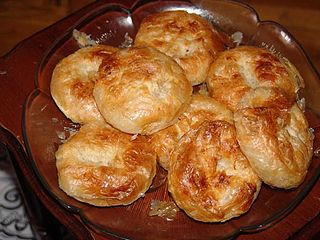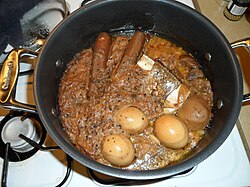
Avgolemono is a family of sauces and soups made with egg yolk and lemon juice mixed with broth, heated until they thicken.

Jewish cuisine refers to the worldwide cooking traditions of the Jewish people. During its evolution over the course of many centuries, it has been shaped by Jewish dietary laws (kashrut), Jewish festivals and holidays, and traditions centred around Shabbat. Jewish cuisine is influenced by the economics, agriculture, and culinary traditions of the many countries where Jewish communities have settled and varies widely throughout the entire world.

Cholent or Schalet is a traditional slow-simmering Sabbath stew in Jewish cuisine that was developed by Ashkenazi Jews first in France and later Germany, and is first mentioned in the 12th century. It is related to and is thought to have been derived from hamin, a similar Sabbath stew that emerged in Spain among Sephardic Jews and made its way to France by way of Provence.

Bourekas or burekas are a popular baked pastry in Sephardic Jewish cuisine and Israeli cuisine. A variation of the burek, a popular pastry throughout southern Europe, northern Africa and the Middle East, Israeli bourekas are made in a wide variety of shapes and a vast selection of fillings, and are typically made with either puff pastry, filo dough, or brik pastry, depending on the origin of the baker.

Sabich or sabih is a sandwich of pita or laffa bread stuffed with fried eggplants, hard boiled eggs, chopped salad, parsley, amba and tahini sauce. It is a staple of Israeli cuisine. Its ingredients are based on a traditional quick breakfast of Iraqi Jews; while in Iraq, the ingredients were served separately, the modern Sabich, where all of them are eaten together in a sandwich, was created in Israel, where it is sold in many businesses.

Jachnun or Jahnun is a Yemenite Jewish pastry, originating from the Adeni Jews, and traditionally served on Shabbat morning, with resek agvaniyot, hard-boiled eggs, and zhug.
Bukharan Jewish cuisine is the traditional cuisine originating from the Bukharian Jewish community of Central Asia, who now mostly reside in Israel, and the United States.

Sephardic Jewish cuisine, belonging to the Sephardic Jews—descendants of the Jewish population of the Iberian Peninsula until their expulsion in 1492—encompassing traditional dishes developed as they resettled in the Ottoman Empire, North Africa, and the Mediterranean, including Jewish communities in Turkey, Greece, Bulgaria, North Macedonia, and Syria, as well as the Sephardic community in the Land of Israel. It may also refer to the culinary traditions of the Western Sephardim, who settled in Holland, England, and from these places elsewhere. The cuisine of Jerusalem, in particular, is considered predominantly Sephardic.

Israeli cuisine primarily comprises dishes brought from the Jewish diaspora, and has more recently been defined by the development of a notable fusion cuisine characterized by the mixing of Jewish cuisine and Arab cuisine. It also blends together the culinary traditions of the various diaspora groups, namely those of Middle Eastern Jews with roots in Southwest Asia and North Africa, Sephardi Jews from Iberia, and Ashkenazi Jews from Central and Eastern Europe.

Hamin or dafina is a Sabbath stew made from whole grains, cubes of meat, chickpeas or beans, onion and cumin that emerged in Iberia among Sephardic Jews. The dish was developed as Jewish chefs, perhaps first in Iberia, began adding chickpeas or fava beans and more water to harisa, a Middle Eastern porridge of cracked durum wheat berries and meat, to create a more liquidy bean stew. The similar Sabbath stew cholent was developed based on hamin by Ashkenazi Jews in Europe, first in France and later Germany.

Mofletta is a Maghrebi Jewish pancake traditionally eaten during the Mimouna celebration, the day after Passover.

Mizrahi Jewish cuisine is an assortment of cooking traditions that developed among the Mizrahi Jewish communities of the Middle East, North Africa and Central Asia. Influenced by the diverse local culinary practices of countries such as Morocco, Libya, Egypt, Iraq, Iran, Yemen, and Syria, Mizrahi cuisine prominently features rice, legumes, meats, and an array of spices such as cumin, turmeric, and coriander. Signature dishes include kubbeh (dumplings), pilafs, grilled meats, and stews like hamin.
Macaroni Hamin is a traditional Sephardic Jerusalemite dish originally from the Jewish Quarter of the Old City of Jerusalem. It consists of macaroni, chicken, potatoes and spices. Traditionally Macaroni Hamin is slow-cooked overnight before Shabbat. Similar to other dishes prepared in communities of Jewish Sephardic and Iraqi origin haminados eggs can be added. Macaroni Hamin is still eaten by Sephardic Jews who have origins inside the Old City of Jerusalem.

Resek agvaniyot, or resek, is an Israeli condiment made of grated tomatoes that is traditionally served with malawach, jachnun, bourekas, kubaneh, and other dishes. It is frequently paired with zhug, and is also commonly served as part of the Israeli breakfast.

Malawach or Melawwaḥ,, is a Jewish Yemenite flatbread that is traditional in the Yemeni cuisine. It was brought to Israel by Yemenite Jews. Malawach resembles a thick pancake but consists of thin layers of puff pastry brushed with oil or fat and cooked flat in a frying pan. It is traditionally served with hard-boiled eggs, zhug, and a crushed or grated tomato dip. Sometimes it is served with honey.

Hélène Jawhara Piñer is a French-Spanish historian, educator, and chef. She is the author of a cookbook on Sephardic cuisine and a study of medieval Jewish food culture in Spain and France. She has published articles and recipes in English, French, and Spanish in magazines and academic journals, and has lectured in cooking programs on the Sephardic culinary heritage among diasporic communities in Europe and in North and South America. She specializes in the recreation of historical recipes, such as hojuelas, a fried pastry that originated in sixteenth-century Spain which Jews in Argentina make for Purim; mufleta, a pastry made by Moroccan Jews for the holiday of Mimouna, which marks the end of Passover; and almodrote, a northern Spanish recipe for eggplant dip which closely resembles recipes for mashed eggplant included in two thirteenth-century Arabic cookbooks from Andalusia. In 2021, she presented a twelve-episode online cooking show on Sephardic culinary history for the American Sephardi Federation.
Sabbath stew was developed over the centuries to conform with Jewish laws that prohibit cooking on the Sabbath. The pot is brought to a boil on Friday before the Sabbath begins, and sometimes kept on a blech or hotplate, or left in a slow oven or electric slow cooker, until the following day.

The cuisine of Jerusalem reflects the long history of Jerusalem as a crossroads of cultures and religions. Millennia of trade, conquest, and migration have resulted in a unique fusion of culinary traditions, with significant influences from Jewish and Levantine Arab cuisine.

















